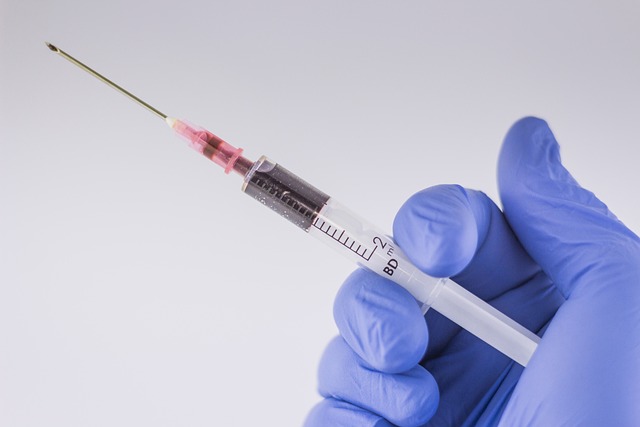Testosterone is a vital hormone for men, with normal levels varying by age (270-1070 ng/dL) and crucial for overall health. Deficiencies can cause several symptoms. Combined testing for testosterone and vitamin D (UK Vitamin D Blood Test) is recommended as both deficiencies are common, especially in those with limited sun exposure. A simple blood test measures hormone levels using advanced techniques like LC-MS, aiding in diagnosing issues like hypogonadism.
In the UK, testosterone level testing plays a crucial role in diagnosing various male health issues. Understanding normal testosterone ranges is essential for overall well-being. This comprehensive guide delves into the significance of these tests, highlighting common health concerns they help identify. From low testosterone to vitamin D deficiency—often indicated by a UK Vitamin D blood test—early detection through accurate testing is key. Learn when and how to consider testosterone level testing as part of your healthcare routine.
- Understanding Testosterone Levels: Normal Ranges and Importance for Men's Health in the UK
- When to Consider Testosterone Level Testing: Common Health Issues in Men
- The Process of Testosterone Blood Testing: What to Expect and How to Interpret Results
Understanding Testosterone Levels: Normal Ranges and Importance for Men's Health in the UK
Testosterone is a key hormone for men, playing a vital role in various aspects of their health and well-being. Understanding its normal ranges is crucial for diagnosing potential issues. In the UK, the typical healthy testosterone level for adult males ranges from approximately 270 to 1070 nanograms per deciliter (ng/dL) or 9.45 to 36.87 nanomoles per liter (nmol/L). These values can vary slightly based on age, with levels naturally declining as men get older.
Men’s health issues often related to testosterone deficiencies can manifest in various symptoms, including decreased muscle mass, fatigue, reduced sexual drive, and depression. A UK Vitamin D Blood Test might be recommended alongside testosterone testing, as vitamin D is also essential for overall health and its deficiency can impact hormone levels. Accurate diagnosis and timely intervention are key; proper medical advice should be sought to address any concerns regarding testosterone levels and overall male health.
When to Consider Testosterone Level Testing: Common Health Issues in Men
Men experiencing various health issues may benefit from considering testosterone level testing. Low testosterone, or hypogonadism, is a common concern that can lead to a range of symptoms such as decreased energy levels, muscle mass loss, and low libido. If these symptoms persist and there’s no apparent cause, it could indicate underlying hormonal imbalances.
In the UK, vitamin D blood tests are often recommended alongside testosterone level checks. Vitamin D deficiency is prevalent in men, especially those with limited sun exposure. Combining a vitamin D test with a testosterone assessment can provide valuable insights into overall male health. This dual approach helps healthcare professionals diagnose and treat conditions effectively, ensuring men receive appropriate care for both hormonal imbalances and nutrient deficiencies.
The Process of Testosterone Blood Testing: What to Expect and How to Interpret Results
Testosterone blood testing involves taking a sample of your blood to measure the level of this hormone in your body. This process is typically non-invasive and can be done at most healthcare facilities or even at home, with some kits available for self-testing. The UK Vitamin D Blood Test, while focusing on another essential nutrient, shares similar sampling and accessibility features. During a testosterone blood test, a healthcare professional will usually draw a small amount of blood from your arm, similar to other routine blood tests. This sample is then sent to a laboratory for analysis using highly sensitive techniques like liquid chromatography-mass spectrometry (LC-MS) for accurate results.
Interpreting the results requires understanding what ‘normal’ levels look like, which can vary based on age and individual health status. Generally, testosterone levels are measured in nanomoles per litre (nmol/L). For men, typical ranges are around 270-1070 nmol/L, though these can differ slightly based on testing methods. Lower-than-expected readings may indicate conditions like hypogonadism or testosterone deficiency, while significantly elevated levels could suggest potential issues with the testicles or adrenal glands. In both cases, further diagnostics are usually required to confirm a specific health issue and guide appropriate treatment, which may include supplements, therapy, or lifestyle changes.
Testosterone level testing is a valuable tool for diagnosing various health issues in men. By understanding normal ranges and knowing when to consider such tests, individuals can proactively manage their well-being. The process is straightforward, involving a simple blood test that interprets levels with precision. For those residing in the UK, accessing this vital diagnostic method can significantly contribute to maintaining optimal male health, especially considering the prevalence of related issues. Just as important as the test results is the subsequent care and treatment plan tailored to each individual’s unique needs.
